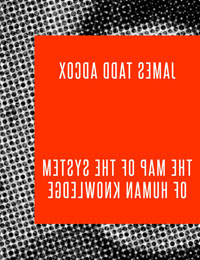 The Map of the System of Human Knowledge
The Map of the System of Human Knowledge
by James Tadd Alcox
Tiny Hardcore Press, 2012
pages / $12 Buy from Tiny Hardcore Press
While The Map of The System of Human Knowledgeis in a lot of small pieces the work can be read as one unified work. Each part is situated on the eponymous map. Formally, each small part of text is tasked with defining a specific category of human knowledge. They do this with disarming simplicity while never addressing or naming the area of the map they represent. Instead, the system of human knowledge is outlined in an oblique or affective way. Each section of the book is a discreet and important section of the map as a whole to the extent that it is revealed in the book. Each piece works as a thing itself, but the effect of the work as a whole is different, as on a map, which allows for some feeling of context and scale. A single piece presented alone does little to evoke the feeling of accumulation that occurs when progressing through the work, but each piece is touching and worth considering on its own.
In “History / Natural / Uniformity of Nature / History of Land and Sea” is in second person. The collection moves easily through points of view. Here the narrator addresses you as you hide in the bathroom from the older woman you picked up at an off season beach bar and you think:
Here salvation or transcendence shows up in a situation of kind of horrifying banality and shows itself as explicitly normal. The “how’re you getting on” is a kindly old-fashioned salutation that you can’t help but answer with a passive platitude of your vague dissatisfaction indicating nothing. It’s a weird fantasy and a weird way to take in stride communicating with this supernatural barber made of light that it works to make the situation satisfying, sad, devastating, even because it is defused. Even in the face of transcendence we’re still “Oh, you know.”
The book moves like this by displacing situations and making things that are normal experience strange and the strangest things into something normal. Some examples: a sea cow shows up, a mother speaks in the language of God because of soup, the sea cow is kind of an asshole that moves in on your girlfriend, there are monarchical belligerent geese, there are strange births, things inside of bodies that usually aren’t, (money, other people) there are many surprising objects, there is David Hume, there are no more dreams, and there is no more soup. There is a vacuum sacrifice.
When the collection is finished it isn’t complete. The Map of The System of Human Knowledge is never finished because it is only a map, a representation, never the system itself. It indicates where things are with relation to each other. Characters still follow this map despite encountering situations that “defy the common experience of all mankind, and so forth” as David Hume says. The characters deal with whatever strangeness in precisely the ways that they are equipped to. This has an effect of leaving the reader feeling both helpless and comforted.
In “Philosophy / Logic / Art of Remembering / Supplement to Memory / Writing / Alphabet / Arts of Writing, Printing, Reading, Deciphering” the narrator writes “I’ve been receiving letters – unsigned, no return address, but with handwriting that looks suspiciously familiar. In fact, it looks like my own.” It could be the opening of a noir film or a Twilight Zone episode but it’s not. The line between quotidian and remarkable here is exceedingly blurry. When something strange happens the characters may feel perturbed or even alarmed, but for the most part the rest of the world continues unchanged. The narrator here consults with a handwriting expert that doesn’t appreciate being bargained with; after all, handwriting professional school is expensive. The handwriting professional, will, however, consult on handwriting over the phone and with a verbal description somehow confirms the narrator’s suspicion that the handwriting is in fact his own. The narrator doesn’t panic but simply wonders what, if anything, he had been trying to tell himself, and when or how he had written these letters without his own knowledge.
Following the The Map of the System of Human Knowledge is a trip that leaves the reader more or less where they started but changed. The reader starts and ends with the same map. The exciting trick of using a map is that is allows you to see the terrain it represents, and it inalterably changes the way that terrain looks. The places of human knowledge are located on the map, in the context of the rest of human knowledge. This effect estranges “common experience”. It makes it weird. And it makes the impossible seem to belong exactly next to and basically the same as what happens every day.
***
Leif Haven is currently in transit. Other writings and etceteras can be found and inquiries inquired at http://leifhaven.com
Tags: James Tadd Alcox, Leif Haven, The Map of the System of Human Knowledge, Tiny Hardcore Press

Tadd is a beast. And he has an excellent new haircut.
Vive Leif, Vive Tadd
This is one of the most enjoyable books I’ve read this year, especially as collections go.
tinyurl.com/cyk9xz2
[…] read the entire review click here. Posted in […]